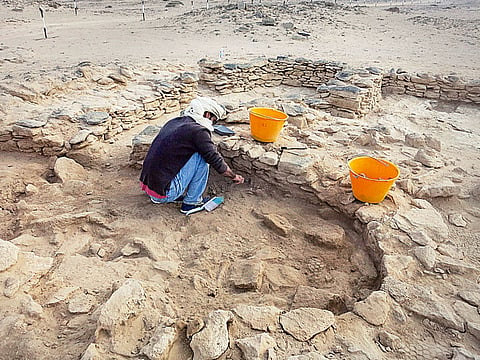Excavations uncover early inhabitants of Abu Dhabi
Late stone age artefacts revealed by new excavations on Marawah Island

Abu Dhabi: New archaeological excavations on Marawah Island have uncovered the earliest known inhabitants of Abu Dhabi, providing a unique insight into life during the Late Stone Age in Abu Dhabi’s Western Region.
A programme of archaeological surveys carried out by Abu Dhabi Tourism and Culture Authority (TCA) since 2012 has identified more than 20 major sites on the island, ranging in date from the Late Stone Age period (around 7,500 years ago) to the recent historical period, with two Late Stone Age villages discovered at the western end of Marawah Island, comprising a series of occupation mounds.
More than 200 flint arrowheads were collected from the surface of the sites, known as MR1 and MR11, while further excavations at MR11 have revealed a very interesting stone building rich in finds.
Mohammad Amer Al Niyadi, director of the Historic Environment Department at TCA, said, “The latest results from our excavations at the Late Stone Age village at MR11 on Marawah Island have produced outstanding results. We now have a clear idea of the plan and form of a 7,500-year-old house, which is one of the earliest known examples of stone-built architecture in the Gulf region.
“One of the most important finds was the discovery of a human skeleton. This partial skeleton was inserted into one of the already semi-collapsed rooms of the house, indicating that the structure had originally been used as a house for the living, and then later as a house for the dead. This burial, found within the central room, was placed in a crouched position on its side with its head oriented towards the east. This form of burial is typical of other known Late Stone Age burials, such as those known from Jebel Buhais in Sharjah emirate, replicas of which can be seen in the Sharjah Archaeology Museum,” Al Niyadi added.
Marawah Island is located around 100km to the west of Abu Dhabi, and is home to important marine and coastal ecosystems.
Dr Mark Beech, head of Coastal Heritage and Palaeontology at TCA and director of the archaeological project on Marawah Island, said, “The latest phase of our work on Marawah Island has concentrated on the investigation of the earliest known settlements in Abu Dhabi, namely, the Late Stone Age settlements at MR1 and MR11. In 2014 we carried out geophysical surveys of both sites, both magnetometry and ground- penetrating radar being used to assess the sub-surface remains. These surveys help us to target potentially interesting structures at the site. Excavations at the MR11 site began in earnest in 2015 and were completed in February 2016 as we concluded our latest field season of work.”
Other finds discovered within the house include beautiful shell and stone beads, as well as a number of interesting stone tools. A large flint spear was found, which may have been used for hunting dugongs or turtles.
Abdullah Khalfan Al Kaabi, a Coastal Heritage archaeologist within the Historic Environment Department at TCA, was responsible for the initial discovery and excavation of the skeleton.
“It is exciting to be directly involved in the discovery of the earliest known inhabitants of Abu Dhabi. I had to clean very carefully around the human bones as they were extremely fragile after being in the ground for more than 7,000 years. We had to treat the bones with Paraloid B72, a special consolidant, to strengthen them before we were able to lift them,” Al Kaabi explained.
The skeletal remains will be examined in the near future by experts to determine more information about the people and their age, gender and health status.
Other notable sites discovered on Marawah Island by the TCA Abu Dhabi archaeological team include a large complex of cooking hearths dating to the Bronze and Iron Age periods (between 5,000-3,000 years ago), some early Islamic period lime kilns, and various sites associated with the historical period (during the past 250 years) when pearling and fishing were the main economic activities. These include a dry-stone walled mosque in Liffa village, a series of middens in Marawah village, an Islamic cemetery and old wooden courtyard house, boathouse and mosque in Gubba village, as well as a nearby traditional water catchment system and wells.
“We still have a large area to excavate at both the Late Stone age villages of MR1 and MR11,” added Dr Beech. “Our recent work has revealed a very interesting tri-partite form of house. This is extremely well built and is made from the local limestone collected from the surrounding area. The walls of the structure are extremely thick, being between 60-70cm wide. This indicates that the structure was created by corbelled walls, which helped to create an elongated dome appearance for the house. Following the construction of the central chamber in an approximately north-south orientation, two additional chambers or rooms were then added to the east and west side of it.”
Finds from the TCA excavation also reveal that the inhabitants of the Stone Age settlement maintained domestic animals, with fragments of sheep or goat bones being identified. Some hunting was carried out for gazelle. For the most part, however, the inhabitants exploited the rich marine resources available around Marawah Island. Bone fragments from both dugong and turtle were identified, showing that these formed a regular part of their diet. Extensive fishing was carried out, as well as the collecting of shellfish for food, and as raw material for the manufacture of jewellery.
Sign up for the Daily Briefing
Get the latest news and updates straight to your inbox



